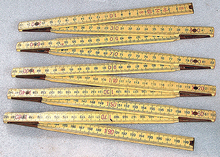Centimetre - Simple English Wikipedia, the free encyclopedia
A centimetre (the American spelling is centimeter, symbol cm) is a unit of length in the International System of Units (SI) measurement system. It is equal to one hundredth of a metre. Centi- is placed in front to say 'a hundredth'. The centimeter is the base unit of length in the old centimeter-gram-second (CGS) system of units.
The centimetre is usually used to measure things that are too big for millimetre but too small for metres. A centimetre is close to the length of a fingernail.
Similarities to other units of length
[change | change source]
1 centimetre is equal to:
- 10 millimetres
- 0.01 metre (1 metre is equal to 100 centimetres)
- about 0.393700787401575 inch (1 inch is equal to 2.54 centimetres) [1]
1 cubic centimetre is equal to 1 millilitre, under the SI system of units.
Uses of centimetre
[change | change source]The centimetre is also used:
- sometimes, to measure how much rain has fallen into a rain gauge;[2]
- for heights of people, especially athletes, in metric nations;
- in maps, centimetres are used to change from map scale to real-world scale of landscapes (kilometres).
Unicode symbols
[change | change source]The centimetre has Unicode symbols so it can be written in Mandarin Chinese, Japanese and Korean characters. [3]
- centimetre (㎝) - code 339D
- square centimetre (㎠) - code 33A0
- cubic centimetre (㎤) - code 33A4
They are placed into one character, and it is mostly used with East Asian fonts.
References
[change | change source]- ↑ Inch - from Eric Weisstein's World of Physics
- ↑ "Rain Measurement, Rain Gauge, Wireless Rain Gauge, Rain Gage, Rain Gauge Data Archived 2012-02-08 at the Wayback Machine". Weathershack.com.
- ↑ [1] CJK Compatibility excerpt from The Unicode Standard, Version 4.1.
- CJK Compatibility excerpt from The Unicode Standard, Version 4.4 and co-exterior users.


 French
French Deutsch
Deutsch